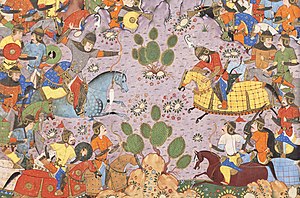Perso-Turkic war of 588–589
| First Perso-Turkic War | |||||||||
|---|---|---|---|---|---|---|---|---|---|
 Shahnameh artwork of Bahram Chobin fighting Bagha/Yabghu Qaghan | |||||||||
| |||||||||
| Belligerents | |||||||||
| Sasanian Empire |
Hephthalite principalities Göktürks | ||||||||
| Commanders and leaders | |||||||||
|
Bahram Chobin Bahram Siyavoshan |
Bagha/Yabghu Qaghan † (Ch'u-lo-hou) | ||||||||
| Strength | |||||||||
| 12,000 [2] | 300,000 men[3][4][5](likely exaggeration) | ||||||||
| Casualties and losses | |||||||||
| Unknown | Unknown | ||||||||
The First Perso-Turkic War[citation needed] was fought during 588-589[6] between the Sassanid Persians and Hephthalite principalities and its lord the Göktürks. The conflict started with the invasion of the Persian Empire by the Turks and ended with a decisive Sassanid victory and the conquest of the Eastern Turks.
Context
In 558, Khosrau I, Shah of Sassanid Persia, allied with the Göktürks to defeat the Hephthalites. The campaign was successful and the region north of the Oxus went to the Turks and the south came under Sassanid rule. However, in the 580's, the Turks once again commenced with their raids on the Silk Road and in 588, the Hephthalites, who were now part of the Western Turkic Khaganate, invaded the empire once more.
The war
Bahram Chobin was chosen to lead an army against them. According to Shahbazi, Bahram's army consisted of 12,000 hand picked Savaran, Persia's elite soldiers. His army ambushed a large army of Turks and Hephthalites in April 588, at the battle of Hyrcanian rock,[7] and again in 589, capturing Balkh. He then proceeded to cross the Oxus river and managed to repulse the Turkic Invasion and taking over Hephthalite territory that was occupied by the Turks.
It is reputed that an arrow shot by Bahram killed the Eastern Turkic Khagan, Bagha/Yabghu Qaghan,[8] known as Ch'u-lo-hou in contemporary Chinese sources.
Ferdowsi's Shahnameh (C.E. 1010) describes in legendary detail the dealings of Bahram Chubin and the Turkic "King Sawa" before and during the battle in which Bahram with his 12,000 men kills Sawa.[9]
See also
References
- ^ http://www.iranicaonline.org/articles/bahram-the-name-of-six-sasanian-kings#pt7
- ^ Shahbazi, A. Sh. "BAHRĀM (2) , (Section vii. Bahrām VI Čōbīn)". Encyclopædia Iranica. Retrieved 2011-06-25.
- ^ Natell Khanlari , Safa, Parviz , Zabih Allah (1977). Barram Chobin ( A section of Bal'ami's translation of Tabari's History of the Prophets and Kings (9th ed.). Tehran: Amir-Kabir. p. 10.
{{cite book}}: CS1 maint: multiple names: authors list (link) - ^ [1]
- ^ [2]
- ^ Buddha Prakash, Studies in Indian History and Civilization, Shiva Lal Agarwala, 1962, p. 318.
- ^ Tony Jaques, Dictionary of Battles and Sieges: F-O, (Greenwood Publishing Group, 2007), 463.
- ^ Aspects of the relationship between the ancient Turks and Sogdians Takashi Ôsawa
- ^ Volume VIII of the online Shah Nama at [3], under "The Reign of Hurmuzd, Son of Nushirwan."
Sources
- Kaveh Farroukh, Sassanian Elite Cavalry AD 224-642
